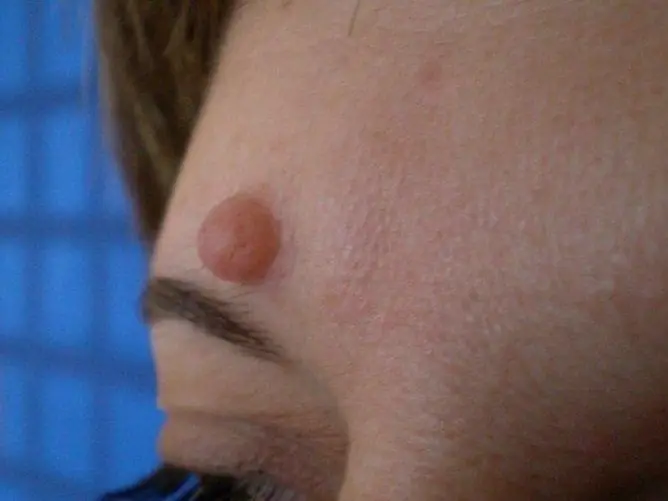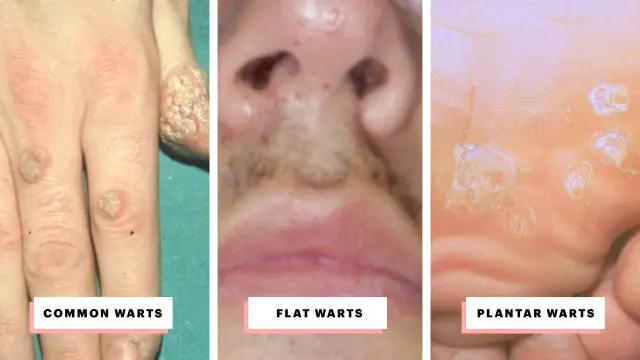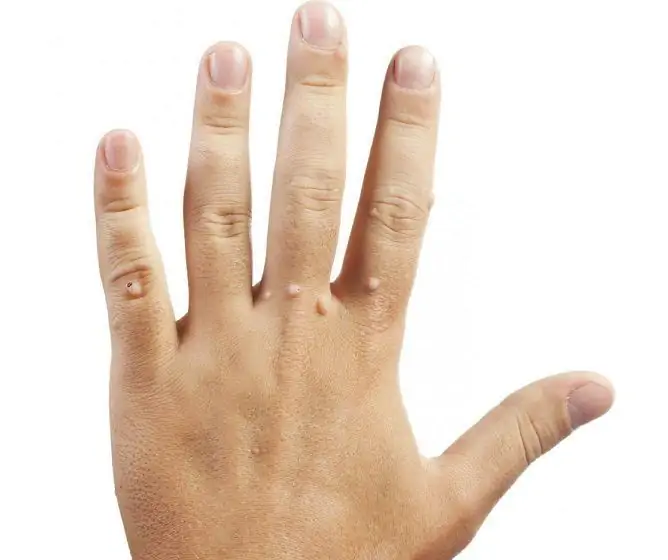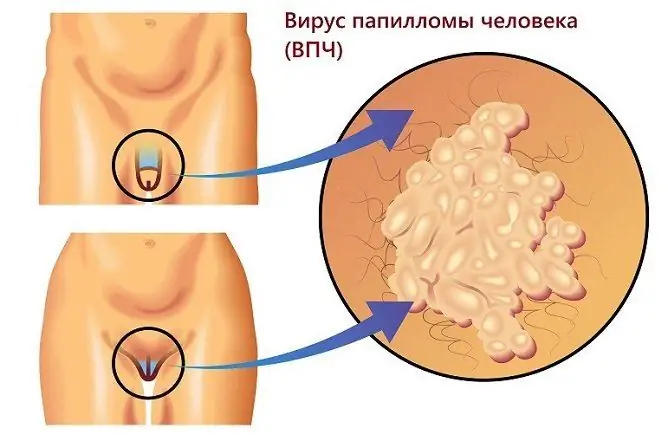- Author Rachel Wainwright [email protected].
- Public 2024-01-15 19:51.
- Last modified 2025-11-02 20:14.
Warts on the face
The content of the article:
-
Why do warts form?
Human papillomavirus (HPV)
- How do warts look and appear?
-
How to get rid of facial warts
- Removal of warts
- Traditional methods
- Prevention
- Video
Facial warts are benign skin neoplasms that often have a viral etiology, can grow in size and grow. The main reasons for the development of pathology include infection with various types of human papillomavirus.
Warts can occur in patients of all age groups. Most often they do not pose a threat to human life and health and are exclusively an aesthetic problem, causing psychological discomfort.

Warts are painless and not dangerous to health, but they cause psychological discomfort
For diagnosis and treatment, consultation with a dermatologist is required.
Why do warts form?
The human papillomavirus, which causes the development of wart neoplasms, is transmitted from person to person through direct contact or through the use of shared objects. Self-infection of a person is possible when shaving, epilation. Probably simultaneous infection with several types of human papillomavirus.
The risk factors for the development of pathology include:
- a history of chronic diseases;
- hormonal changes (including at puberty and during the period of bearing a child);
- frequent stressful situations;
- decreased immunity;
- increased sweating of the skin;
- increased oily skin;
- age-related changes in the body.
Irritation and damage to the skin (cuts, scratches) contribute to the occurrence of warts.
Human papillomavirus (HPV)
To date, more than 600 strains of human papillomavirus are known, some of which cause the development of neoplasms. For example, flat warts can develop when infected with the 14th, 15th, 27th HPV strains.
In addition, when infected with some types of the virus in humans, pathologies of the reproductive organs, condylomas of the perianal region, as well as oncological diseases (when infected with oncogenic strains) can occur. Scientists have identified a link between HPV infection and the development of cervical cancer, cancer of the vagina, penis, anus, squamous cell carcinoma of the oral cavity, pharynx and larynx.
There are several types of warts (presented in the table).
| View | Description |
| Ordinary (vulgar) | Dense dry neoplasms with an uneven surface, painless, can merge, forming plaques, most often occur on the hands; a variety of this group are plantar warts. |
| Flat (youth) | Rounded or irregular skin neoplasms that practically do not rise above the level of the skin, which appear on the skin of the face and hands, most often appear in children and young people. |
| Senile (age-related keratomas) | Plaques of gray, black or brown color, which are covered with horny masses impregnated with sebum; not associated with infection with viruses, develop in elderly patients on the skin of the face, neck, trunk. |
| Genital warts | Small pink nodules that are able to merge, forming a papillary growth on a thin stalk, most often occur on the genitals, in the perianal region. |
| Acrochords (filamentous warts or filamentous papillomas) | They have an oblong (filamentous) shape; when grouped together, they visually resemble a cock's comb. |
How do warts look and appear?
The incubation period for papillomavirus infection is usually several months (1-8 months), its duration, first of all, depends on the state of the human immune system - it can last for several years, and often HPV persists in the body without showing itself. Symptoms appear when immunity is weakened for one reason or another (cold, hypothermia, overheating, severe stress, etc.).
Vulgar:
- painless;
- rough to the touch;
- in the photo they look like growths, nodules or bumps that are above the level of the skin;
- there is no skin pattern on the surface of the neoplasm, after its removal it appears again;
- fresh nodules are flesh-colored or white and turn gray or brown over time;
- the appearance of zones of altered epithelium on other parts of the body (often on the back of the hands) is possible.
Acrochords (filiform):
- often occurs in people over 35 years of age;
- usually localized in the eyelids, on the skin around the eyes, lips, nose, on the chin, can occur in the armpits, under the mammary glands in women, in the groin;
- painless, in some cases, patients experience itching in the affected area.
How to get rid of facial warts
Often, wart formations disappear on their own within two years after their occurrence, but it is very difficult to predict whether they will disappear on their own or not. Warts are removed for cosmetic purposes, but this does not mean that HPV is cured.
Removal of warts
Warts are mainly removed with gentle methods, especially on the face, since the goal is to get rid of a cosmetic defect, and not to add additional tissue trauma. The procedure is performed on an outpatient basis under local anesthesia.
Cryodestruction
One of the most effective methods for removing skin growths on the face is cryodestruction using liquid nitrogen. Usually 2-3 procedures are sufficient. The advantage of the methods is painlessness and absence of scars. The disadvantage is the inability to control the depth of the effect on the tissue.
Laser therapy
The least traumatic way to remove neoplasms is to use a laser. The formation is removed in layers. After treatment with this method, a small depression remains on the skin, which levels out within 2-3 weeks.

Laser wart removal is one of the most popular and effective methods, but the risk of recurrence remains
Electrocoagulation
The method consists in exposing the affected area to a high frequency current. After the procedure, a crust remains on the site of the wart formation, which is rejected after a while, leaving no traces. This method is not suitable for deep removal of facial lesions, as a small scar may remain.
Surgical excision
This method is rarely used on the face, as a noticeable scar remains on the skin after surgery. Surgical removal is used only when there are contraindications to less traumatic methods, and in areas that are not conspicuous (for example, in the temporal region, where the skin is partially covered by hair).
In addition, surgery may be required if the tumor:
- bleeds;
- started to hurt;
- increases in size;
- has fuzzy borders, painted in bright red;
- acquired black color.
In this case, there is a need to exclude the oncological process, therefore, after removal, the wart is sent for histological examination.
Traditional methods
Trying to remove warts on the face at home using folk remedies is not recommended, as this is highly likely to lead to the development of complications. So, attempts to self-treat neoplasms on the skin can lead to the spread of the infectious process to other areas of the skin, burns, and the appearance of rough scars on the skin.
Prevention
In order to prevent pathology, general strengthening and hygienic measures are recommended:
- wash hands thoroughly with soap and water after visiting public places, etc.;
- avoid the use of general hygiene products and bedding;
- carefully handle all damage to the skin;
- strengthen the immune system: avoid stressful situations, eat right and adhere to a healthy lifestyle.
Video
We offer for viewing a video on the topic of the article.

Anna Aksenova Medical journalist About the author
Education: 2004-2007 "First Kiev Medical College" specialty "Laboratory Diagnostics".
Found a mistake in the text? Select it and press Ctrl + Enter.






